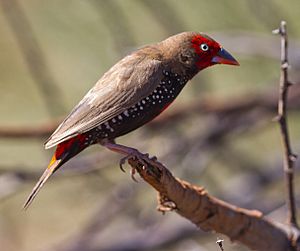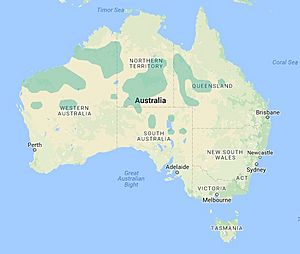Painted finch facts for kids
Quick facts for kids Painted finch |
|
|---|---|
 |
|
| Male in Western Australia | |
| Conservation status | |
| Scientific classification | |
| Genus: |
Emblema
|
| Species: |
pictum
|
 |
|
| Painted finch distribution | |
The painted finch (Emblema pictum) is a small, colorful bird. It is a type of estrildid finch found in Australia. This bird got its name because of the red and white spots on its belly. Both male and female painted finches have these unique markings.
Its scientific name, Emblema pictum, also tells us about its look. Emblema means "mosaic" or "inlaid work". Pictum comes from a Latin word meaning "painted". People sometimes call it the Emblema finch or Painted firetail. Many people enjoy keeping painted finches as pets in their backyard aviaries.
Contents
About the Painted Finch
What is Taxonomy?
Taxonomy is how scientists group living things. It helps us understand how different animals are related. The painted finch belongs to a group called the Emblema genus.
Long ago, scientists thought four types of birds were in this group. But newer studies showed that three of them were different. These three birds are now in a group called Stagonopleura. They include the Beautiful firetail, Red-eared firetail, and Diamond firetail. So, the painted finch (Emblema pictum) is now the only bird in the Emblema genus.
The Estrildidae Family
The painted finch is part of the Estrildidae family. This family includes many small passerine birds. Passerine birds are often called perching birds. They live naturally in places like Africa, southern Asia, and Australasia.
There are about 124 different kinds of estrildid finches. Scientists believe this bird family first appeared in India. From there, they spread to Africa and Australia.
What Does the Painted Finch Look Like?
The painted finch is a small bird. It is usually about 10 to 12 centimeters (4 to 5 inches) long. It weighs around 11.5 grams (about 0.4 ounces).
Male Painted Finches
Male painted finches have a bright red forehead and face. This red color stands out against their black chest. They also have a bright red patch in the middle of their chest. The sides of their chest and belly are black with white spots. Their tail and upper body are a reddish-brown color. Their rump, which is the area above their tail, is also mostly red. This red patch is easy to see when the bird flies.
Males have a long, thin, pointed beak. The top part of the beak is mostly black with a red tip. The bottom part is mostly red with light blue-gray spots near its base. Their eyes are a creamy white color. Their legs can be dark brown or pinkish.
Female Painted Finches
Female painted finches look a lot like the males. However, the red color on their face is not as bright. It is mostly around their eyes and cheeks. The red patch on their chest is also duller than the male's. Their underparts are generally a duller brownish-black. But the spots on their belly are usually more noticeable.
A female's beak is similar to a male's. But it usually has less red on the top part. Her eyes are also creamy white. Her legs can be dark brown or pinkish, just like the males.
Young Painted Finches
Young painted finches, called juveniles, look similar to females. But their underparts are duller and more brown. They do not have the red color on their face. Their beak is black, but it becomes lighter and almost pinkish on the bottom part. Young painted finches have gray-brown eyes.
Life and Habits of the Painted Finch
Behaviour
Painted finches usually live in pairs or small groups. Sometimes, you can see large groups of up to 100 birds. This happens when they gather around water sources. These big groups might even include other types of finches or honeyeaters.
Painted finches are generally quieter than other Australian finches. However, their calls are quite loud and can sound harsh. Their contact calls sound like ‘trut, chek-chek’ or ‘ced up, cheddy-up’. When a male is alone, he often makes a loud, wheezing, chattering song. Female painted finches make a rattling sound if there is danger near their nest.
Diet
The painted finch mainly eats grass seeds. They especially like seeds from spinifex plants. Sometimes, they might also eat fruit or small pieces of grass. These birds look for food on the ground. They hop and bounce among rocks and clumps of grass. They pick up fallen seeds from the ground.
In captivity, painted finches have been seen catching flying termites. They also pick aphids, which are tiny insects, from plants. However, scientists have not seen them eating insects in the wild.
Reproduction and Life Cycle
If the weather is good, painted finches can breed almost any time of the year. Eggs have been found in every month except November and December. Young birds have been seen in nests between March and October.
Courtship usually happens on the ground. Both the male and female pick up small twigs or other items and then drop them. Sometimes, the male will sing to the female. He stands tall, puffs up his feathers, and moves his head from side to side.
Painted finches stay with one partner for life. They build their nests in simple pairs. Nests are usually hidden well in clumps of spinifex grass. They might also nest in natural holes near the top of a grass clump. Sometimes, they even build nests on the ground at the base of a plant. They might also use other types of grasses or small bushes for nesting.
Their nests are loose and shaped like a bottle or a dome. They have a wide entrance. Nests are usually made of spinifex stems. They might also use other grass stems, twigs, or small roots. The inside of the nest is often lined with soft materials. These include feathers, plant fluff, hairy seeds, wool, or fur. The opening of the nest is sometimes decorated with a piece of charcoal.
Female painted finches lay 3 to 5 oval-shaped white eggs. The eggs sometimes have a light blue tint. Both the male and female take turns sitting on the eggs. This incubation period lasts about 13 to 14 days. The young birds are born helpless and without feathers. They stay in the nest for about 21 to 26 days. Their parents feed them for about two more weeks after they leave the nest. Young painted finches start to show courtship behavior when they are about 10 weeks old.
Where Do Painted Finches Live?
The painted finch lives in dry and semi-dry areas. They prefer rocky places that have spinifex grass growing on the ground. You can find painted finches in Western Australia, Northern Australia, Queensland, and South Australia.
In 2007 and 2008, many painted finches moved into western New South Wales. Since then, they have been seen breeding there. Scientists now believe that a new group of painted finches has made this area their home.
See also
 In Spanish: Diamante pintado para niños
In Spanish: Diamante pintado para niños


